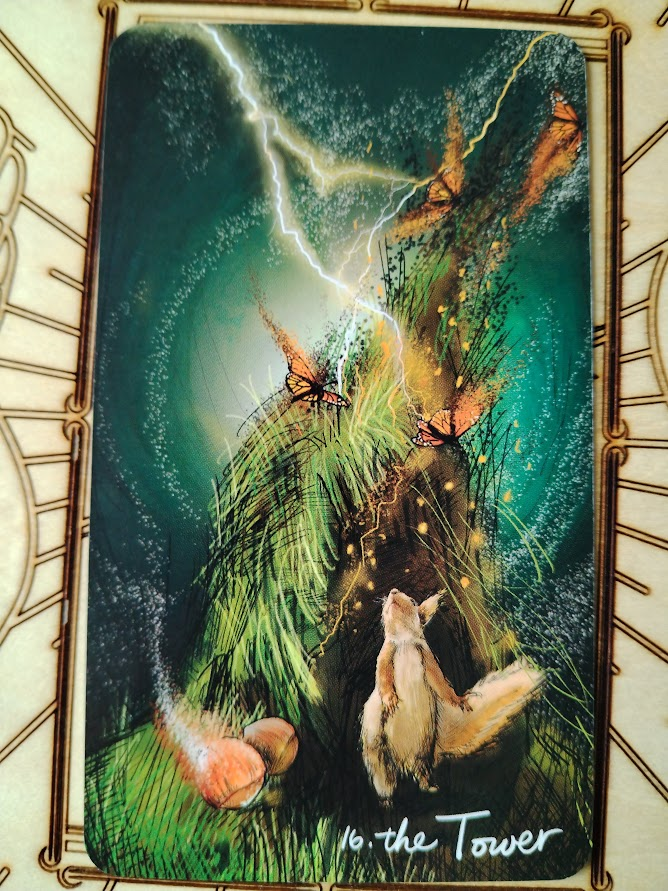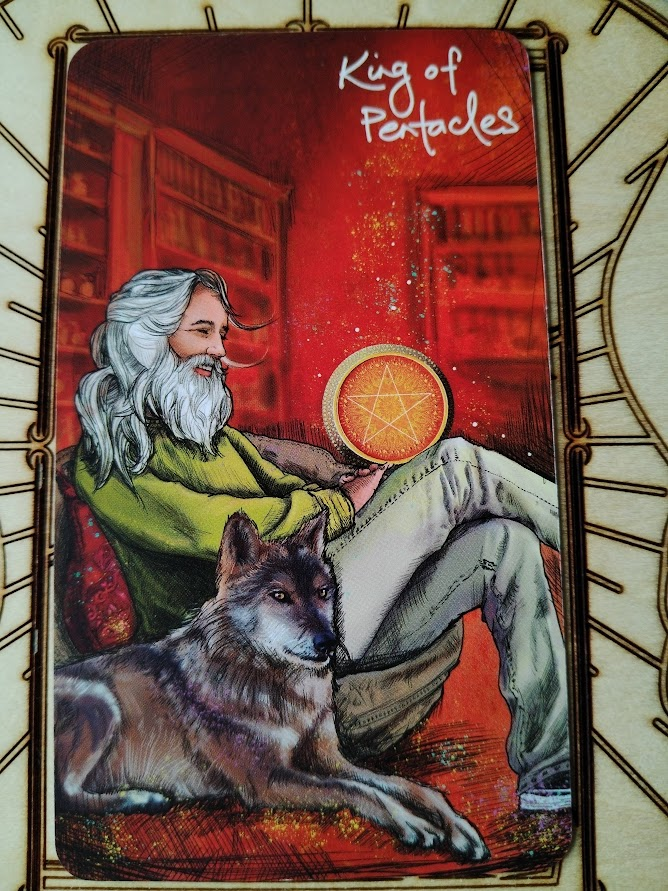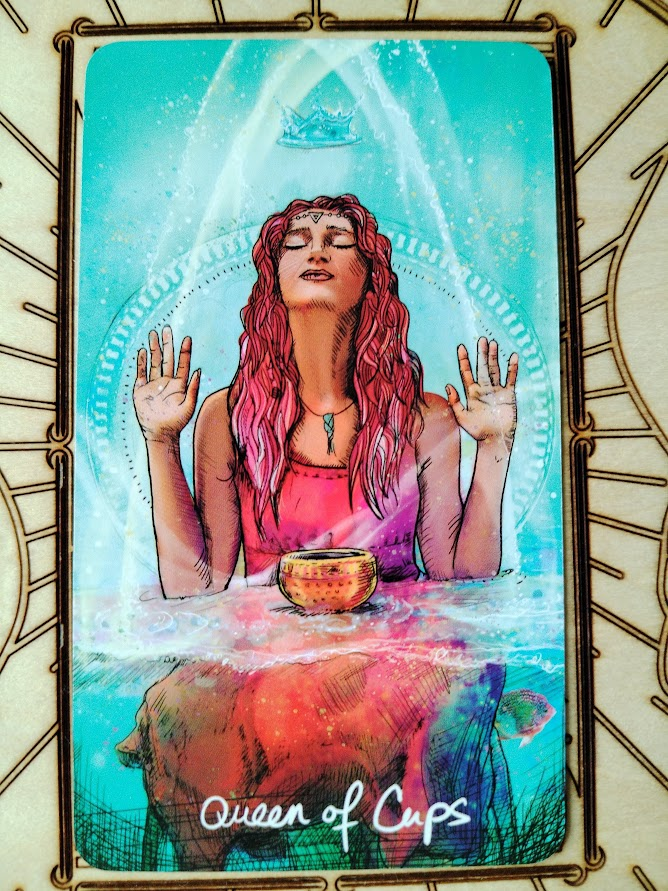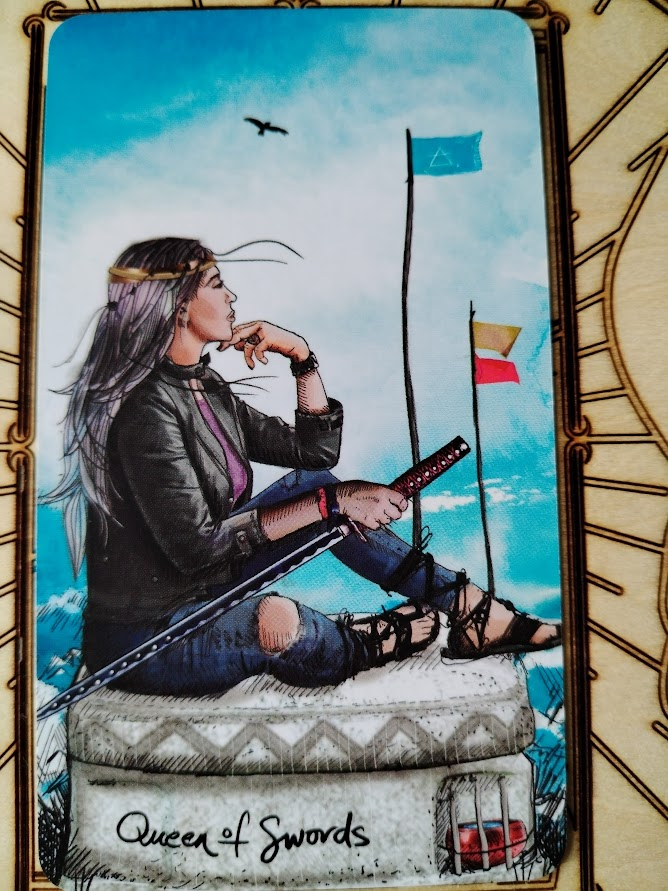This 78-card tarot deck is a healing tool and guide to explore both the light and shadow sides of our nature.
By reimagining the traditional tarot archetypes and symbols in a contemporary, boho, and intuitive style, The Light Seer's Tarot expresses the light and shadow sides of our natures and explores the lessons that can be learned from both.
The expressive characters who live within the landscapes of the cards tell stories, ask questions, and provide guidance. This deck is an ideal companion as you seek to uncover the places in your life-and in yourself-that are most in need of illumination.
You can see the unboxing on TikTok or youtube and the silent flickthrough on TikTok or youtube. I posted the interview spread and Inner Harmony spread, and I reviewed the indepth guide book, Tarot for Light Seers, which I highly recommend!
I. First Impressions
The Minor suits aren't tied together by colour as they are in some decks, but that doesn't mean they don't feel unified.
The suit of Cups is represented by bowls, evoking a sense of emotional receptivity and flow. The Queen of Cups stands out with a powerful image of immersion—she is waist-deep in water, symbolizing her deep connection to her emotions and intuition. The King, in contrast, is seated on the surface of the water, suggesting a more stable, balanced relationship with his feelings, yet still in harmony with the fluidity around him. The Knight and Page cards both include water as a background element, with the Page being more immersed than the Knight, reinforcing the varying depths of emotional engagement each character represents.
The suit of Swords is symbolized by birds, primarily crows, which reflect the intellectual and often sharp nature of this suit. The birds are present as a constant, sometimes as a subtle background element, and other times as the central focus of the card. Crows dominate the imagery, representing wisdom, clarity, and the keen sight needed to navigate through challenges. The King of Swords features an owl—a bird associated with intellect and perspective—yet it’s accompanied by a crow, which brings an added dimension of mystery and depth to his authoritative energy.
A clever detail appears on the Queen of Swords card: she’s perched atop a pedestal with a small fenced-off niche just beneath her, containing a single Cup. This placement suggests that while the Queen keeps her emotions in check, she has them—she simply chooses to keep them under control, maintaining the clarity and balance needed to wield her intellect effectively.
The suit of Pentacles is symbolized by circles, often intricately patterned in a way that evokes the feeling of sewn or tapestry designs. While a few cards feature the traditional Pentacle, most of the cards showcase mandalas, which bring an added sense of harmony, balance, and interconnectedness to the material world. A standout feature in several cards—such as the Ace, Seven, and Page—are the roots that emerge from the circles, symbolizing growth, stability, and the connection between the spiritual and the physical. These roots serve as a reminder of the importance of staying grounded as you build and grow in the material realm.
In the Eight of Pentacles, moon cycles appear within the mandala to represent the passage of time and the patience needed for mastery. This subtle detail reflects the theme of dedication and consistent effort, with each phase of the moon symbolizing a step in the process of learning and refining one's skills.
The suit of Wands is strongly tied to the element of fire, and nearly all of the cards feature Wands used as torches, representing inspiration, passion, and action. This imagery of fire perfectly conveys the dynamic and energetic nature of the suit, whether it’s a spark of creativity or the intensity of pursuing one’s goals.
There are a couple of exceptions to this fiery theme: the Page and the Seven of Wands. In these, the focus shifts slightly, with the Page more symbolically linked to the potential of fire, and the Seven stepping away from the torch-like imagery. However, in the Queen of Wands card, fire is represented by candles rather than the Wand itself, emphasizing the Queen’s nurturing yet powerful control over her inner flame.
Unboxing Experience: There are two versions of this deck, the standard and pocket sized. As it happens, I own both! The standard deck comes in a two part box; the mini is in a tin. Both are decorated with artwork from the cards, and both boxes are just about the same size as the cards.
Artwork Style: Chris-Anne describes the art as "contemporary, boho, and intuitive," and I think that's spot-on. While I'm no art expert, "boho" - or even "hippie" - feels like the right vibe. The imagery is full of dancing, free-spirited energy, and flowing clothes, which I absolutely love. The cards radiate brightness that goes beyond just colour, capturing their meanings in a gentle yet modern way. This deck is often recommended for beginners, and it’s easy to see why. Although it generally follows the Rider-Waite-Smith system, it feels more grounded and relatable, bringing the meanings into a real-world context.
II. The Cards
Artwork Style: Chris-Anne describes the art as "contemporary, boho, and intuitive," and I think that's spot-on. While I'm no art expert, "boho" - or even "hippie" - feels like the right vibe. The imagery is full of dancing, free-spirited energy, and flowing clothes, which I absolutely love. The cards radiate brightness that goes beyond just colour, capturing their meanings in a gentle yet modern way. This deck is often recommended for beginners, and it’s easy to see why. Although it generally follows the Rider-Waite-Smith system, it feels more grounded and relatable, bringing the meanings into a real-world context.
II. The Cards
Major Arcana: The Majors have Strength at 8 and Justice at 11. Titles are written, in a sort of handwriting font, at the base of each card, though they move around a little depending on the illustration. The numbers, unusually, are in Arabic. The cards follow the RWS in general, but they've all been updated, with all religious imagery removed; The Lovers is simply a couple, no angels or snakes, the Devil is simply a compelling male, Judgement has a spirit raising out of a woman's body with no graves in sight. The Tower is a lightning-struck tree, the Hanged Man is an acrobat hanging from a cloth sling - the spirit is very much there in every image.
Minor Arcana: The Minors are fully illustrated and, as with the Majors, they follow the sense of the RWS without being slaves to the imagery. The Courts, especially, have been updated; no one is sitting stiffly on thrones here. Instead it feels as though we've peered into their lives in a moment that sums them up beautifully; the Knight of Swords is on the move, the King of Pentacles is relaxing in his study and so on. The characters on these cards feel alive and like people you might meet on the street any day.
The suit of Cups is represented by bowls, evoking a sense of emotional receptivity and flow. The Queen of Cups stands out with a powerful image of immersion—she is waist-deep in water, symbolizing her deep connection to her emotions and intuition. The King, in contrast, is seated on the surface of the water, suggesting a more stable, balanced relationship with his feelings, yet still in harmony with the fluidity around him. The Knight and Page cards both include water as a background element, with the Page being more immersed than the Knight, reinforcing the varying depths of emotional engagement each character represents.
The suit of Swords is symbolized by birds, primarily crows, which reflect the intellectual and often sharp nature of this suit. The birds are present as a constant, sometimes as a subtle background element, and other times as the central focus of the card. Crows dominate the imagery, representing wisdom, clarity, and the keen sight needed to navigate through challenges. The King of Swords features an owl—a bird associated with intellect and perspective—yet it’s accompanied by a crow, which brings an added dimension of mystery and depth to his authoritative energy.
A clever detail appears on the Queen of Swords card: she’s perched atop a pedestal with a small fenced-off niche just beneath her, containing a single Cup. This placement suggests that while the Queen keeps her emotions in check, she has them—she simply chooses to keep them under control, maintaining the clarity and balance needed to wield her intellect effectively.
The suit of Pentacles is symbolized by circles, often intricately patterned in a way that evokes the feeling of sewn or tapestry designs. While a few cards feature the traditional Pentacle, most of the cards showcase mandalas, which bring an added sense of harmony, balance, and interconnectedness to the material world. A standout feature in several cards—such as the Ace, Seven, and Page—are the roots that emerge from the circles, symbolizing growth, stability, and the connection between the spiritual and the physical. These roots serve as a reminder of the importance of staying grounded as you build and grow in the material realm.
In the Eight of Pentacles, moon cycles appear within the mandala to represent the passage of time and the patience needed for mastery. This subtle detail reflects the theme of dedication and consistent effort, with each phase of the moon symbolizing a step in the process of learning and refining one's skills.
The suit of Wands is strongly tied to the element of fire, and nearly all of the cards feature Wands used as torches, representing inspiration, passion, and action. This imagery of fire perfectly conveys the dynamic and energetic nature of the suit, whether it’s a spark of creativity or the intensity of pursuing one’s goals.
There are a couple of exceptions to this fiery theme: the Page and the Seven of Wands. In these, the focus shifts slightly, with the Page more symbolically linked to the potential of fire, and the Seven stepping away from the torch-like imagery. However, in the Queen of Wands card, fire is represented by candles rather than the Wand itself, emphasizing the Queen’s nurturing yet powerful control over her inner flame.
Card Stock and Size: The standard deck is 13 by 8 cm, while the mini is 6.05 by 4.95. Both are easy to shuffle; they feel sturdy, and they slide over each other easily without catching. I often find myself reaching for the minis when my hands want to be busy.
Writing Style and Readability: If you're interested in the deck you should consider investing in the extended guidebook, linked above, but the books that come with the decks, the Little White Books, are very thorough and easy to follow as well. Chris-Anne talks through getting to know the cards, deciding whether to use reversals or not, and the genesis of the deck, all in plain language.
Card Meanings: Each card has two pages. In the standard LWB, there's an image of the card, upright and reversed keywords - called Light Seer and Shadow Seer - a few paragraphs describing the meaning, and a topic sentence, perfect to use in meditation or journaling. The mini LWB has everything bar the image of the card.
Spreads and Techniques: The books include five spreads, a one card draw, a two card, two three cards and a four card. Apart from the one card, they all involve deliberately reversing cards in at least one position, which leads to some interesting readings! The extended guide book has ten spreads, plus one for each Major Arcana card.
IV. In Use
Spreads and Techniques: The books include five spreads, a one card draw, a two card, two three cards and a four card. Apart from the one card, they all involve deliberately reversing cards in at least one position, which leads to some interesting readings! The extended guide book has ten spreads, plus one for each Major Arcana card.
IV. In Use
Intuition and Connection: This was one of my very first decks and I loved it as soon as I started using it. The energy feels very gentle and every day, the images feel like scenes from real life and the characters feel like real people.
Clarity of Readings: I found the readings I did with this deck flowed beautifully. My usual Querant said the readings were just fine, no 'wow' moments, until the last one which definitely hit the nail on the head. One of my online readers also thought one daily card was perfect for that day.
Suitability for Different Skill Levels: Since this does follow RWS, just more up to date, I do think it would work well for beginners - I was basically a beginner when I started using it, and I found it a good starter deck. Having a deck without the explicitly Christian influence of the RWS may be a draw for some users.
Clarity of Readings: I found the readings I did with this deck flowed beautifully. My usual Querant said the readings were just fine, no 'wow' moments, until the last one which definitely hit the nail on the head. One of my online readers also thought one daily card was perfect for that day.
Suitability for Different Skill Levels: Since this does follow RWS, just more up to date, I do think it would work well for beginners - I was basically a beginner when I started using it, and I found it a good starter deck. Having a deck without the explicitly Christian influence of the RWS may be a draw for some users.
Final Thoughts
This is one of my favourite decks, and it's one that I can put down for a while and come back to without missing a beat. It's great for beginners or for more experienced readers, and with the extended guidebook you can really dig into the art and the influences. A great package all around.













No comments:
Post a Comment